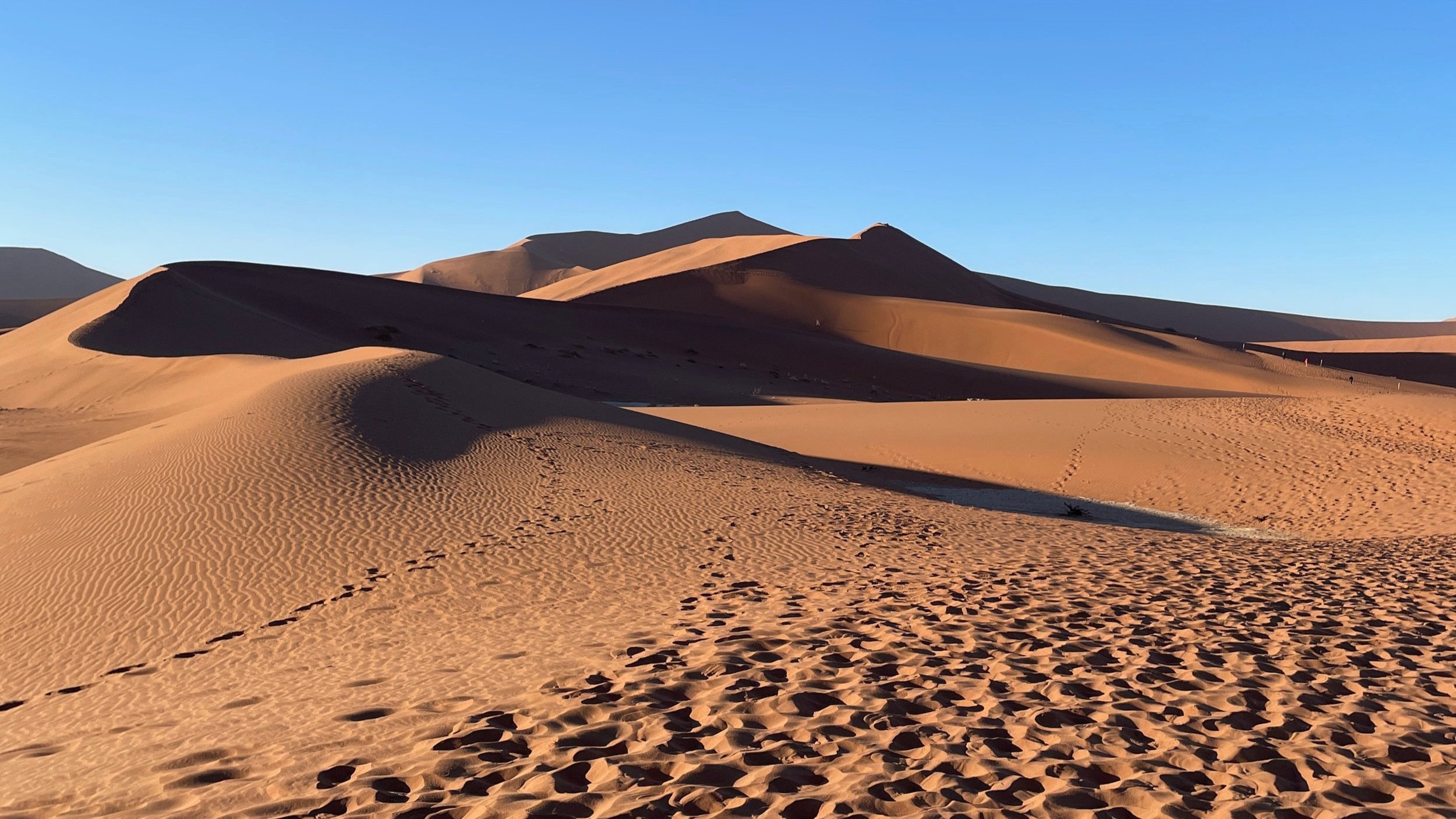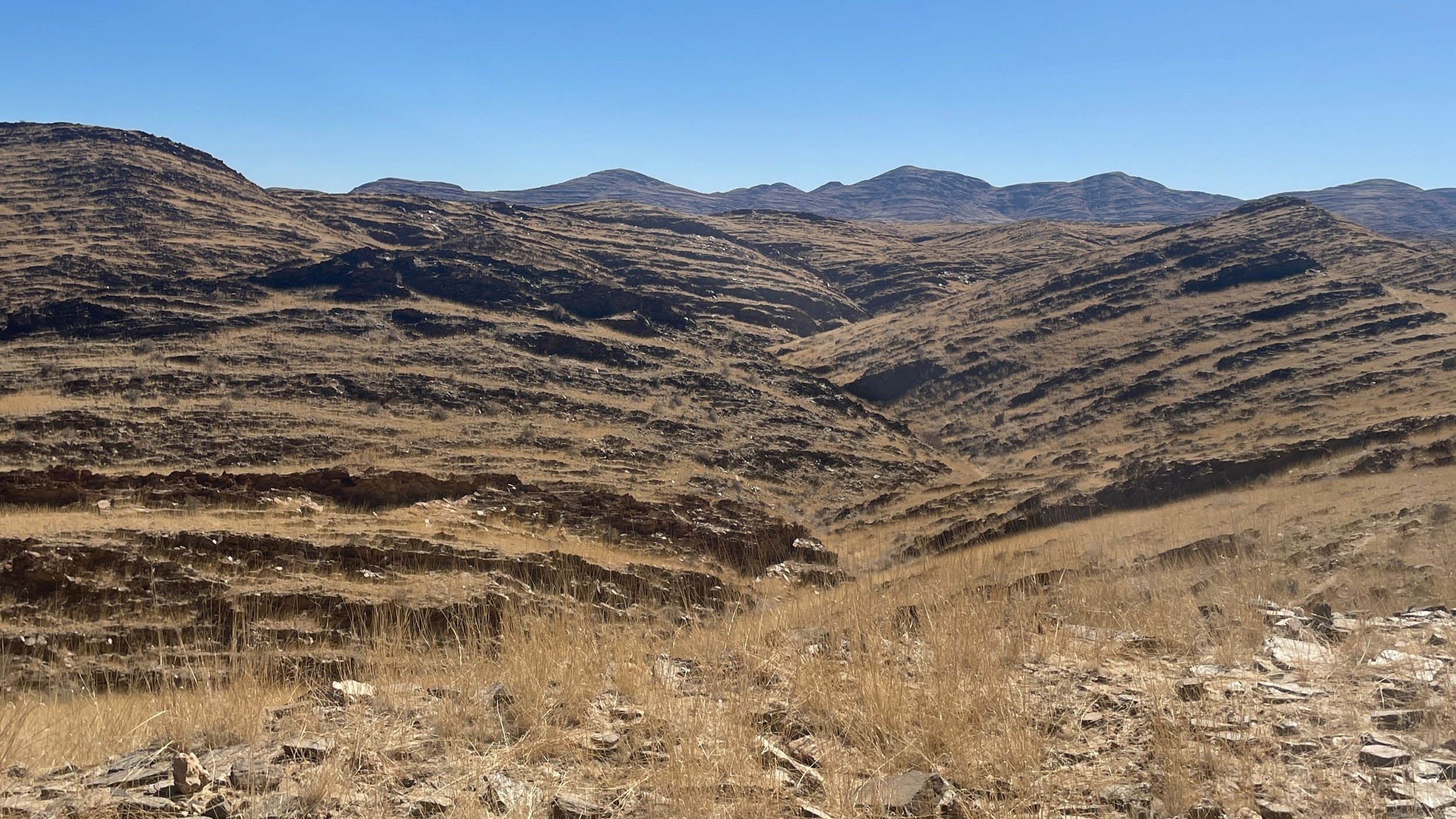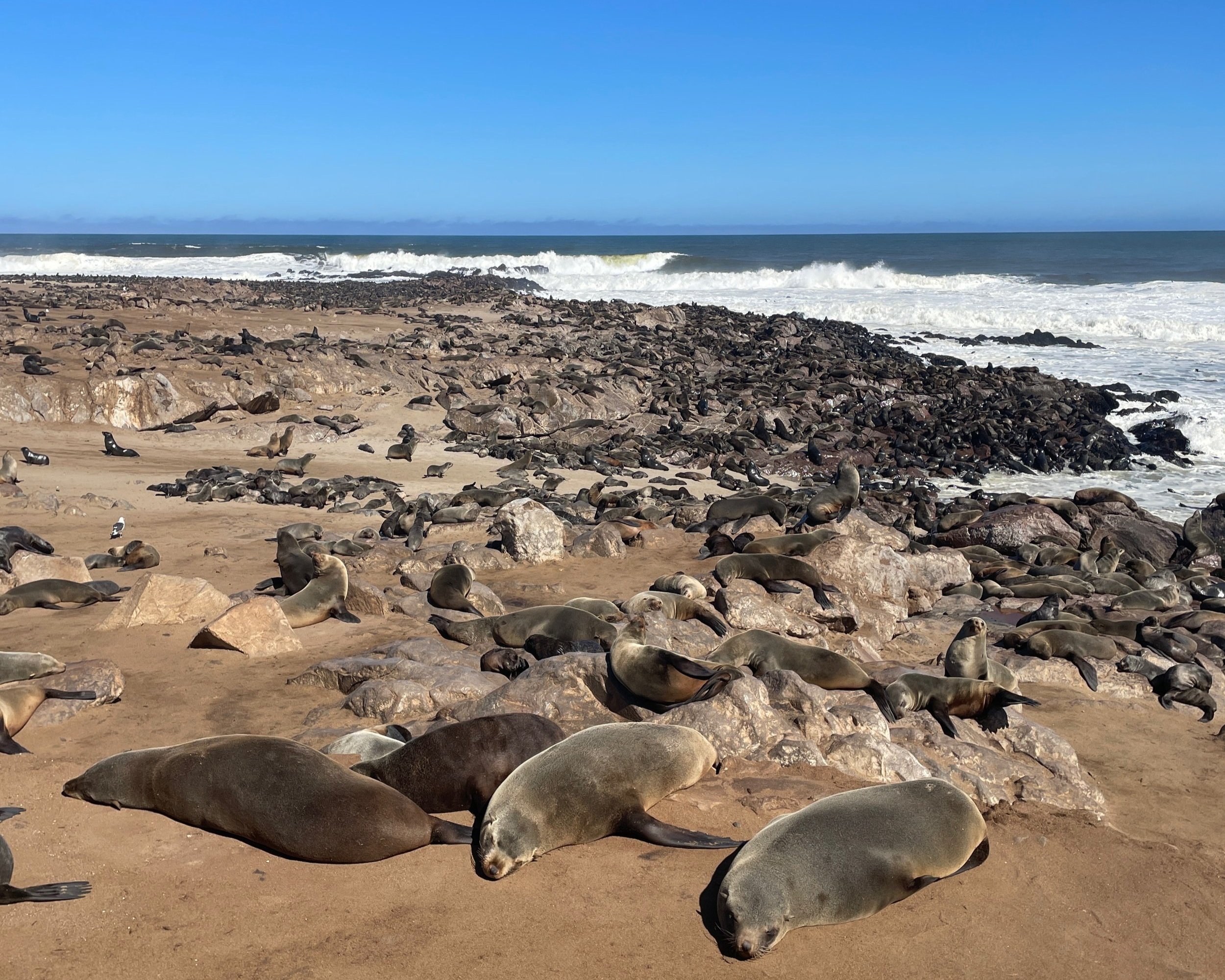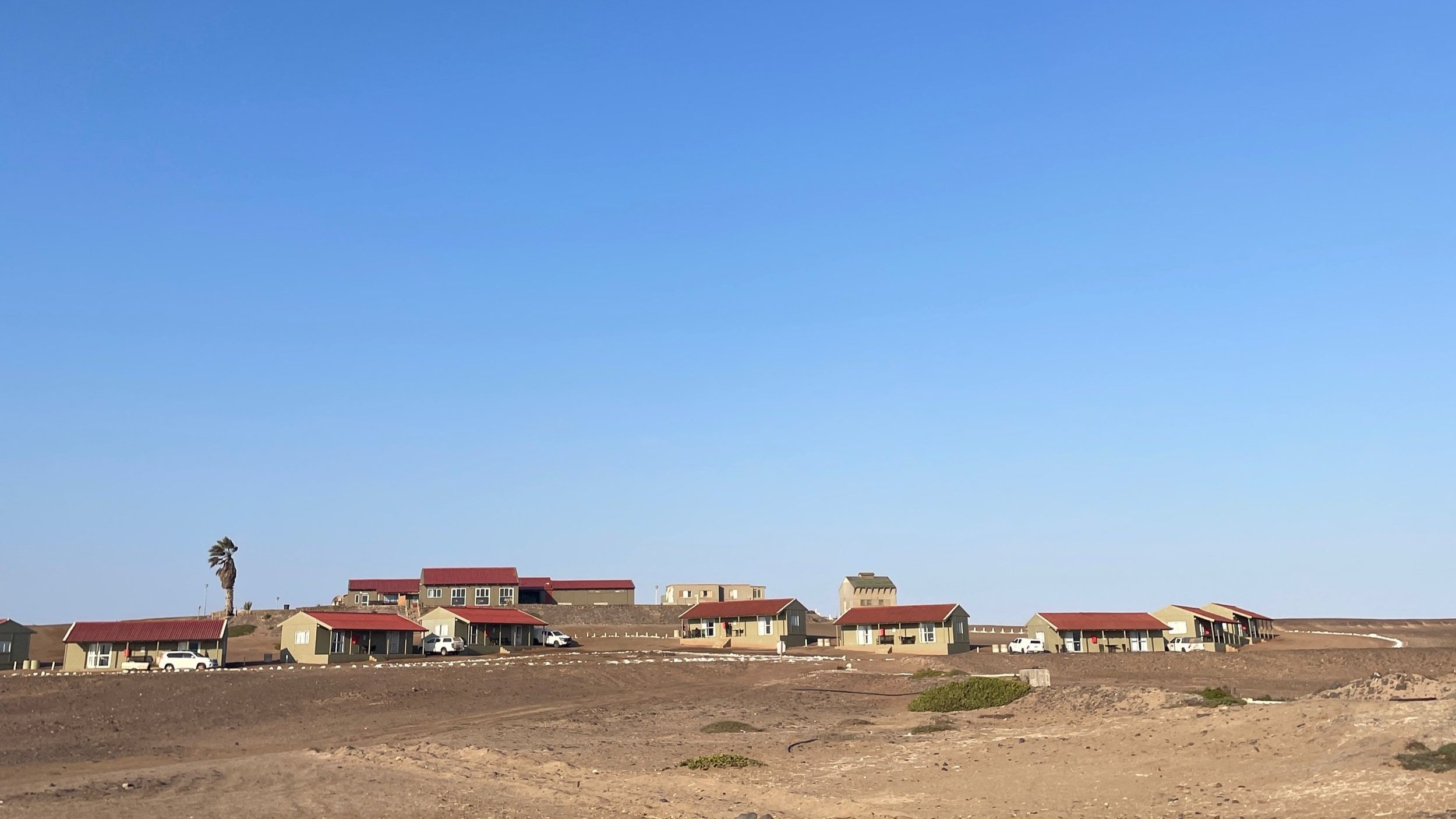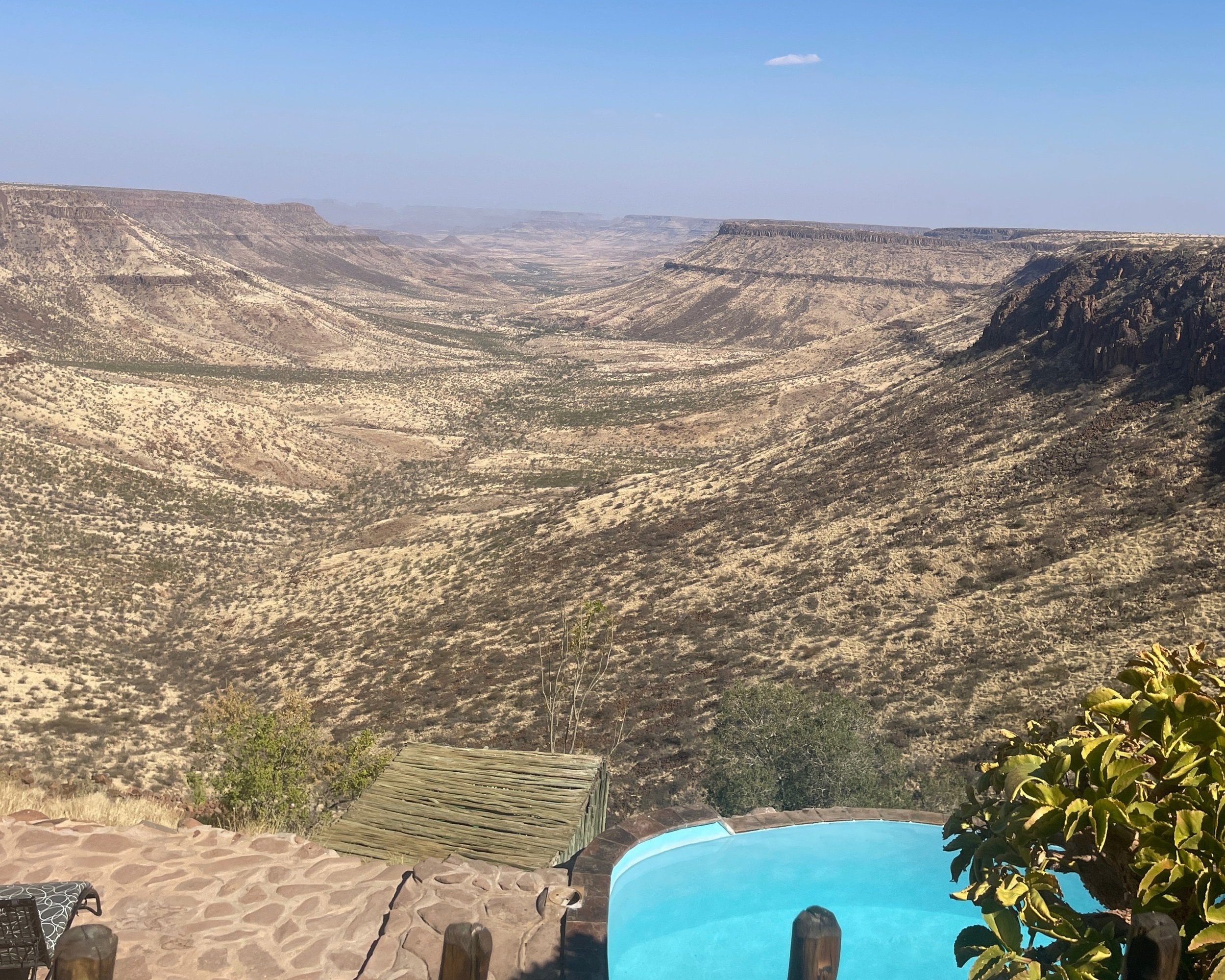Namibia: The ultimate two-week itinerary
There are different routes you can take around Namibia, but after months of research, this was the circuit that was best for us. It meant that we were able to fit in all the main things we wanted to see within two weeks, and had plenty of time to explore Etosha National Park. It meant that we weren’t able to see Fish River Valley and some of the more southern sights. So it’s worth looking into all the options before deciding on the right route for you.
Here’s a quick rundown of our route around Namibia:
Day 1: Windhoek to Sesriem via Spreetshoogte Pass (accommodation: Sossusvlei Lodge)
Day 2: Sossusvlei National Park: Deadvlei, Big Daddy Dune, Dune 45 (accommodation: Sossusvlei Lodge)
Day 3: Sossusvlei to Swakopmund: 5-6 hour drive via Solitaire, the Tropic of Capricorn, Kuiseb Pass (accommodation: The Delight Hotel, Swakopmund)
Day 4: Walvis Bay and Sandwich Harbour (accommodation: The Delight Hotel, Swakopmund)
Day 5: The Skeleton Coast to Terrace Bay: 5 hour drive via Cape Cross Seal Reserve (accommodation: Terrace Bay Resort)
Day 7: Terrace Bay to Grootberg Lodge: 4-5 hour drive (accommodation: Grootberg Lodge)
Day 8: Grootberg Lodge (accommodation: Grootberg Lodge)
Day 9-11: Etosha National Park (accommodation: Okaukeujo Camp and Halali Camp)
Day 12: Mushara Lodge (accommodation: Mushara Lodge)
Day 13-14: The Cheetah Conservation Fund, Otjiwarongo (accommodation: Cheetah View Lodge)
Read on for full information on this itinerary…
Day 1: Sesriem via Spreetshoogte Pass and Solitaire
We landed at Windhoek at 8am, and our first stop was to get a SIM card from the MTC phone shop at the airport. On the 40 minute drive from the airport to Windhoek we saw giraffes and baboons on the side of the road.
After picking up our car, it was a 4.5 hour drive to our final stop for the night – Sossusvlei Lodge in Sesriem. We stopped at Spar in Maerua, Windhoek to stock up on snacks, water, and food that’s easy to make on the road. This was a theme of our trip, and we ate car sandwiches almost every day!
Windhoek to Sesriem
There are two ways of getting to Solitaire from Windhoek, but taking the B1 to Rehoboth means you’re on tarmac for longer. Taking the C26 from Windhoek will put you on gravel roads almost immediately.
Stopping at Spreetshoogte Pass, Solitaire, and for a couple of roadside breaks to pee or take photos or the view, the drive from Windhoek to Sossusvlei Lodge took 5 hours 20 minutes.
The roads were mostly fine despite the gravel, and in a 4x4 (or even smaller cars) you’ll be able to traverse the roads in this direction through Spreetshoogte – so don’t be put off by the many reviews online that warn against how steep it is. It’s steep – but I’ve travelled over much steeper hills in England.
We didn’t have time to stop at Solitaire for photos or to see their bakery’s famous apple pie, but our route passed again on the way to Swakopmund in a couple of days time.
We stayed at Sossusvlei Lodge for two nights, with dinner and breakfast included. Due to the lack of restaurants – or any amenities – in Namibian villages, look for accommodation that has meals included. The food here was great with loads of choice, including for veggies. And the bar was stocked with beer, cider, wine, and spirits for cocktails.
Day 2: Sossusvlei: Deadvlei, Big Daddy, and Dune 45
Sossusvlei National Park opens at sunrise and closes at sunset so check the times during your visit. Staying at Sossusvlei Lodge is a 2-minute drive to the entry gate, and then a 50 minute drive to the first car park. You can catch a shuttle from here to Deadvlei or drive on the sand road to the 4x4 car park which is about 5 km further on.
The shuttle from the 2WD car park is 180 NAD per person and definitely favourable to letting air out of your 4x4’s tyres and driving yourself (unless you like doing that kind of thing). On the way back, they took us round a couple of extra viewpoints before taking us back to the car.
Deadvlei
We arrived at Deadvlei before the sun had risen over Big Daddy dune, which casts an amazing light over the trees. We then spent about an hour in The Valley as the sun rose. Our driver suggested that we should climb the dune first as there are paths that lead you down from Big Daddy into Deadvlei, but we wanted to catch the first light. Early morning or sunset are also the best times to catch the shadows against the dunes.
Big Daddy dune and Dune 45
When we did begin climbing the dune it was so windy and so much sand was being blasted against us that we stopped before reaching half way. We were told that this usually dies down by midday.
We stopped at Dune 45 and Elim dune on the way back, but Deadvlei is definitely the most impressive sight at Sossusvlei. After lunch at a picnic spot we were back to Sossusvlei Lodge before 2pm, where we relaxed by the pool for the rest of the day.
On a busy trip like Namibia, take the time to rest and relax where you can. It might feel like you’re wasting time when there’s so much to see, but it’s much needed between long days of driving.
Day 3: Swakopmund via the Tropic of Capricorn and Kuiseb Pass
The drive from Sossusvlei to Swakopmund is long but incredible, with landscapes ranging from desert to mountains to savannah. Google Maps will tell you the drive takes 4 hours 20 minutes. But with stops along the way and gravel roads preventing you from hitting the speed limit, it takes more like 5 or 6.
Our first stop was at Solitaire, which we only had time to stop at for gas the day before as it was almost sunset. This time we were able to stop and get photos of the derelict cars, and wildlife like mongoose and ground squirrels. This is also a great place to stock up on snacks from the stop and bakery.
Then we went on to the Tropic of Capricorn sign, which we stopped at for about 5 minutes to take photos. The sign on the right-hand side of the road has a better backdrop for photos, with mountains in the background. But if you’d prefer to stay on the left you’ll still get an impressive picture of the vast open road.
Next we drove through Kuiseb Pass, stopping briefly to eat lunch. You could explore some of the low mountains around the riverbed here, but we chose to drive on.
The remaining two hours to Swakopmund are long and bumpy up to Walvis Bay. The scenery is amazing, but the vastness can make your head spin a bit after driving for so long so make sure you have music, podcasts, or some conversation to keep you awake!
We arrived at the Delight in Swakopmund by 4pm and had a drink at Kücki’s pub before going to Jetty 1905 for a delicious dinner.
Day 4: Walvis Bay and Sandwich Harbour
Walvis Bay is about 30 minutes south of Swakopmund, so it might seem counterproductive to go back on yourself to visit the next day. But the harbour town is rough around the edges and Swakopmund is a much nicer (and safer) place to spend two nights on Namibia’s west coast.
We took a half-day 4x4 tour of Sandwich Harbour with Mola Mola Safaris. From the friendly tour guide to the amazing sights, this is definitely something worth doing on your trip here. There are also full-day options that include a boat tour, and longer trips that include a beach braai (bbq).
Our tour left at 12:30pm and returned at 5:30pm. We visited flamingos in Walvis Bay Lagoon, the salt works, Pink Lake, and Sandwich Harbour. This included a long beach drive, spotting wildlife including seals, jackals, oryx, springbok, and pelicans, exploring the dunes on foot and by 4x4, and finishing with a light but delicious lunch in the dunes with sparkling wine and beer.
For dinner we went to Brauhaus, a German pub that serves huge portions for very affordable prices. It’s unlike us not to explore more pubs and bars on holiday, but Namibia is so quiet - even in the cities - and the days are so long and adventure-packed that we were in bed by 10pm most nights!
Day 5: Brandberg via Spitzkoppe
After another great buffet breakfast at our hotel, we set off for the two hour drive to Spitzkoppe. The rocky area is known for its impressive formations, red-orange granite, and ancient carvings.
We spent about 1.5 hours at Spitzkoppe, visiting the rock arch and rock pool on the south west corner of the park. It costs 290 NAD to enter and you can drive the well-marked sand tracks around to each sight. You could spend much longer here, and can even camp in the grounds, but we didn’t have time to visit the carvings or the north side of Spitzkoppe.
Brandberg White Lady Lodge
From there, we drove on another two hours to Brandberg White Lady Lodge next to the amazing Brandberg Massif. We had booked a 3pm desert elephant drive
Our guide Kelvin took us into the Ugab riverbed - which hasn’t had water for over a year due to climate change. He had seen elephants earlier that morning and said we had a good chance of spotting them, but it took an hour of driving until we found them.
We were able to follow the herd of 17 elephants, including a 2.5 year old baby and lead by a matriarch called Matilda, back towards our lodge for another hour. Seeing elephants was the thing I was most excited about for this trip and seeing them up close was unreal. They were so peaceful… until Tusky, the dominant male, wanted us to leave and started flapping his ears and stomping at us.
We were back just in time to watch the incredible red sunset over Brandberg mountain. And after dinner, the stars were the most amazing I’ve ever seen.
Day 6: Skeleton Coast to Terrace Bay
From Swakopmund we drove the Hentiesbaai to fill up the tank, then started the long road up the Skeleton Coast. There are a couple of shipwrecks that can be seen near the town, and the rest are at fishing points along the desolate road.
We also stopped to look at an abandoned oil rig, and at Cape Cross Seal Reserve. Less than an hour outside of Hentiesbaai, the reserve is home to a colony of hundreds of thousands of seals. It’s amazing to see - especially as you notice that the rocks you’re driving towards are actually hundreds of sunbathing seals with their pups, and that the sea is filled with seals too. But the smell is sickening and we stayed less than 20 minutes.
The drive along the Skeleton Coast is both desolate and stunning. At many points, the Atlantic is visible, but the landscape changes dramatically from coastline to red mountains to pure white gravel roads to rocky, silver dunes. Obviously this was also the first place we encountered a punctured tyre, and had to spend 50 minutes on the side of the deserted road changing it!
Arriving at Terrace Bay, our home for the night, felt like arriving at the end of the world. The rooms were simple, but with a view of the wild ocean, and the bar and restaurant was scrawled with messages from visitors who had stayed before.
Day 7-8: Grootberg Lodge
After 5 hours and one incredibly steep Low 4x4 drive uphill, we arrived at Grootberg Lodge. Located on the top of a plateau and looking out for miles across the savannah, Grootberg Lodge is an amazing and unique place to stay. It’s owned by and employs local villagers from the conservancy in the area, and has a rustic local feel despite luxury elements like a pool and cocktail bar.
We spent two days relaxing here, and took the sundowner drive on our second day. This took us around the conservancy and we learned more about the area, before stopping for drinks at an incredible spot to watch the sunset over the mountains. There are also elephant and rhino tracking tours, and self-hiking routes - though we only did a fast 20 minute loop of the grounds as there was a risk of encountering a lion in the area!
Day 9-11: Okaukuejo and Halali, Etosha National Park
The drive from Grootberg to Okaukuejo, just inside Andersson’s Gate at Etosha National Park, took about 4 hours. We spent two nights at Okaukuejo camp in Etosha, and our third and final night at Halali.
At Okaukuejo we stayed in a Water Chalet right near the waterhole, and spotted elephants, giraffes, zebras, springbok, wildebeest, jackals, and a number of birds within minutes of arriving.
You can only enter and leave the campgrounds between sunrise and sunset so we took a short drive to the Okondeka waterhole and back which took about 1 hour 20 minutes including stops to look at giraffes, ostrich, wildebeest – which look like they could be rhinos from a distance – and hundreds of springbok.
When we got back, a rhino had arrived at Okaukuejo waterhole, and was soon joined by around 40 elephants including tiny babies. Staying at this camp meant we were also able to sit around the waterhole at night and watch five black rhinos start fights with each other.
On day 10, we woke up at sunrise to see what wildlife was at the waterhole but it was surprisingly quiet. Only a rhino and a wildebeest were there for the first two hours of the morning. So we went out for the day and explored the waterholes of Okondeka, Nebrownii, Homob, Olifantsbad, Salvadora, and Reitfontein.
The most amazing spot was of a young male lion lying in the shade of a tree. We sat to watch him for about 40 minutes, as the springbok, zebra, and wildebeest at the waterhole anxiously skittered between the water and spots further from the threat. While we were watching, a leopard jumped from the canopy of the tree, across to a different branch. We only caught a glimpse, but leopards are a very rare sighting so it was good enough for us!
After a final night in Okakuejo, we spent the next day driving across to Halali camp, stopping at different waterholes along the way. That night we joined Halali’s night drive, and the following morning we did a sunrise tour. Though they aren’t cheap, these safaris are worth doing if you want to experience the park while nobody else is there. The guides are really knowledgable and your chance of seeing animals that hunt in the night or early morning is much higher.
For more information about our amazing safari experience at Etosha, and a full list of all the amazing animals we encountered, read our blog here.
Day 12: Mushara
After our final morning in Etosha, we made our way through to Namutoni and left the park at the Von Lindequist Gate. After three long days driving around the park, we spent the night at Mushara Lodge.
Taking the time to relax between days of long driving is a must in Namibia, as it can become very tiring despite being sedentary most of the time. Like Grootberg Lodge, Mushara Lodge was the most expensive place we stayed – and possibly one of the most expensive hotels we’ve ever booked. But the space and the food was amazing and it was a lovely place to relax in the sun for an afternoon.
Day 13: Cheetah Conservation Fund, Otjiwarongo
On our last full day in Namibia we stayed at Cheetah View Lodge on the grounds of the Cheetah Conservation Fund in Otjiwarongo.
Staying here was a perfect and relaxing way to end our trip, and it was great to get up close with cheetahs, which we had not seen at Etosha. The CCF does extensive work to help protect cheetahs in Namibia and educate farmers who perceive them to be a greater risk to their animals than they really are. CCF also raises dogs to work with farmers to help protect their farms. It was amazing and inspiring to learn so much about what the charity does.
To find out more, read our blog here.
What animals will you see in Namibia?
One of the main reasons people visit Nambia is to see the wildlife, and we were not disappointed. In two weeks driving across the country we saw:
Baboons
Giraffe
Elephants
Zebra
Black rhino
White rhino
Lion
Cheetahs
Brown Hyena
Spotted Hyena
Jackal
African wildcat
Meerkat
Cape Fox
Yellow mongoose
Mongoose
Ground squirrel
Scrub hare
Dassie
Rock Hyrax
Kudu
Oryx
Dikdik
Springbok
Impala
Wildebeest
Haretebeest
Steenbok
Oribi
Warthog
Flamingos (lesser and greater)
Ostrich
Eagle
Vultures
Hornbill
Kori bustard
Goshawk
Spotted owl
Secretary bird




